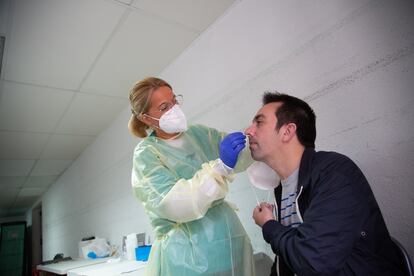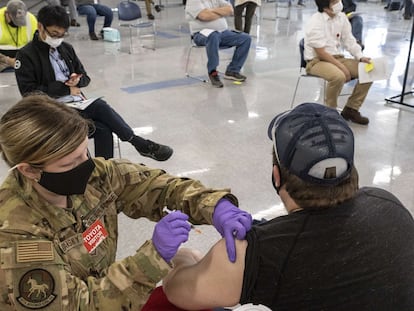Spain reports nearly 6,300 new coronavirus cases, adds 100 deaths to official toll
Although the incidence rate fell slightly from Tuesday, the curve of the epidemic continues to be at very high levels


Spain continues to be at high risk from the coronavirus. While the incidence fell slightly from the day before in Tuesday’s Health Ministry report on the health crisis, by three points, the curve of the epidemic continues to be at very high levels. The 14-day cumulative number of coronavirus cases per 100,000 inhabitants came in at 196 on Tuesday, while the infection rate is growing in 11 regions.
The ministry recorded 6,292 new infections in its latest report, and added 100 Covid-19 fatalities. The data did not include information from Andalusia, which had “technical problems” with its reporting. Meanwhile, there are still around 10,000 coronavirus patients who are currently hospitalized, with one in every five intensive care unit (ICU) beds occupied by people with Covid-19.
Experts warn that the current restrictions in place will have to be ramped up to contain the transmission of the virus
While the incidence fell slightly on Tuesday, it is too early to say whether this represents a slowdown in infections – especially given that only now is the effect of increased social contact and mobility during Easter week being reflected in the data. That said, the rate of new hospital admissions has slowed down and there are fewer people receiving treatment than on Monday: 9,953 patients, with 2,152 in the ICU.
The North African cities of Ceuta and Melilla currently have an incidence of around 500 cases per 100,000 inhabitants. In terms of the regions, meanwhile, the Basque Country, Madrid and Navarre are in the worst situation, with a 14-day cumulative number of coronavirus cases per 100,000 inhabitants of 330, 341 and 425, respectively.
According to Fernando Simón, the director of the Health Ministry’s Coordination Center for Health Alerts (CCAES), Navarre is among the regions that carry out the highest number of tests and as such detects more infections: 2,738 per 100,000 inhabitants. “Navarre is in an ascending phase, but it has made an effort to introduce control measures,” he said on Monday. “Lifestyles, the climate, and the way people interact can have a big influence. Taking measures is not the same as them being complied with. The implementation of measures can be difficult due to the distribution of the population.”
Madrid, meanwhile, whose regional government has always opted for laxer restrictions than other regions, has been suffering a high incidence rate for several months now. In fact, it hasn’t dropped below 200 cases per 100,000 inhabitants since mid-August. Together with Catalonia and La Rioja, the region has the highest ICU-occupation rate in Spain: 40% of these beds are occupied by Covid-19 patients. The Health Ministry’s traffic light risk system sets the high danger level at 25% and over.
Since the start of the pandemic, 76,625 people in Spain have died after a coronavirus infection was confirmed
The majority of Spain’s regions have opted to tackle this growing fourth wave of the epidemic by keeping the social restrictions agreed for Easter week in place, such as perimetral lockdowns. But some have gone even further: Catalonia, for example, has confined all of its comarcas – a territorial division in parts of Spain – while Aragón announced on Tuesday that it would be implementing perimetral lockdowns in Fraga, Cuarte de Huerva and the comarca of La Litera until May 9. The latter measures include the closure of businesses at 8pm and capacity limits of 30% for the inside of bars, Elisa Tasca reports.
The experts consulted by EL PAÍS believe that the fourth wave will not be as severe as the previous ones in Spain, but warn that the current restrictions in place will have to be ramped up to contain the transmission of the virus.
Since the start of the pandemic, 76,625 people in Spain have died after a coronavirus infection was confirmed, although the true death toll is likely much greater given that access to testing was limited during the first wave and many people died with symptoms compatible with Covid before they could be diagnosed. According to Tuesday’s report, 251 people in Spain have died over the last seven days after being diagnosed with Covid-19.
English version by Simon Hunter.
Tu suscripción se está usando en otro dispositivo
¿Quieres añadir otro usuario a tu suscripción?
Si continúas leyendo en este dispositivo, no se podrá leer en el otro.
FlechaTu suscripción se está usando en otro dispositivo y solo puedes acceder a EL PAÍS desde un dispositivo a la vez.
Si quieres compartir tu cuenta, cambia tu suscripción a la modalidad Premium, así podrás añadir otro usuario. Cada uno accederá con su propia cuenta de email, lo que os permitirá personalizar vuestra experiencia en EL PAÍS.
¿Tienes una suscripción de empresa? Accede aquí para contratar más cuentas.
En el caso de no saber quién está usando tu cuenta, te recomendamos cambiar tu contraseña aquí.
Si decides continuar compartiendo tu cuenta, este mensaje se mostrará en tu dispositivo y en el de la otra persona que está usando tu cuenta de forma indefinida, afectando a tu experiencia de lectura. Puedes consultar aquí los términos y condiciones de la suscripción digital.
More information
Últimas noticias
Most viewed
- Oona Chaplin: ‘I told James Cameron that I was living in a treehouse and starting a permaculture project with a friend’
- Reinhard Genzel, Nobel laureate in physics: ‘One-minute videos will never give you the truth’
- Sinaloa Cartel war is taking its toll on Los Chapitos
- Why the price of coffee has skyrocketed: from Brazilian plantations to specialty coffee houses
- Silver prices are going crazy: This is what’s fueling the rally










































